2014 Aprilia Tuono V4R ABS Review
The best streetable superbike - for now
At the risk of giving away the plot before the end of the story, I’m here to say Aprilia’s Tuono V4R is one of the most scintillating and capable sportbikes ever made. And the subtle modifications for 2014 have made a coveted bike even more coveteder.
Aprilia Tuono V4R ABS
| Engine | 19/20 |
| Suspension/Handling | 12.5/15 |
| Transmission/Clutch | 9/10 |
| Brakes | 9.5/10 |
| Instruments/Controls | 3.5/5 |
| Ergonomics/Comfort | 8/10 |
| Appearance/Quality | 8.5/10 |
| Desirability | 9/10 |
| Value | 8/10 |
| Overall Score | 87/100 |
Our opinions about the Tuono’s immensely high capabilities and charisma were solidified during our 2012 Literbike Streetfighter Shootout. The Aprilia handily won the racetrack portion, leaving Triumph’s Speed Triple R and MV Agusta’s Brutale 1090 R chasing the Tuono’s magically sweet V-4 exhaust snarl. The Trumpet makes for a comfier and better-balanced street machine, but the Tuono is the clear choice for first-degree hooligans.
For 2014, the Tuono receives several updates, including addressing our beefs about a stiff and slippery seat and a fuel tank that gets depleted too quickly. A new set of Brembo brakes brings ABS into the equation, and the Aprilia Performance Ride Control (APRC) suite of electronics gets software tweaks.
Motor-Head
While the electronics are interesting, let’s begin instead with the Tuono’s most seductive element – its delicious 65-degree V-4 powerplant, one of the finest mills ever bolted between two wheels. Aprilia has doctored up its airbox for greater efficiency and uses taller intakes for the throttle bodies. Together with a revised exhaust system, the 1,000cc Tuono is purported to crank out 168 crankshaft horsepower, a trio of horses higher than previous.
However, our independent dyno testing failed to corroborate Aprilia’s claims for more power. Our bike spat out a considerable 145 horsepower to its rear wheel, but that nice number is lower than the 154 horses we recorded from our 2012 test unit. While it’s true the bikes were tested on different dynos many months apart, we didn’t expect to see this much less power with the new Tuono.
The Sound of Music
But you’ll never notice the missing ponies riding the Tuono on the street, as it still pushes out 20 or more thoroughbreds than its Triumph and MV rivals, even if its low-end torque curve can’t match its larger-displacement rivals. It always feels eager to romp, almost like a two-stroke, delivering smackdown performance whenever asked. And the transmission’s first three gear ratios are shorter than its RSV4 brother, endowing it with more explosive responses at any street speed.
Luciano Pavarotti’s voice pales in comparison to the soul-stirring song belted out by Aprilia’s engaging V-4. It’s both sweet and nasty at the same time, creating a bellowing tune as sung on world championship racetracks around the world, with a wild crackle on overrun. The Tuono is the closest you can get to a MotoGP streetfighter.
The engine’s appeal is nearly matched by its slick and precise transmission featuring a quick-shifter that allows swift upshifts without touching the clutch lever. The clutch’s slipper function eases sloppy downshifts. The tranny’s only demerit is that neutral access isn’t always reliable, especially while rolling to a stop, and that engaging first gear at a stop is often accompanied by an unbecoming clunk.
Technobabble
Okay, now that we’ve praised the Tuono’s feral-yet-pleasing drivetrain, we’ll get to the bike’s cutting-edge electro wizardry. While the three-level launch control and quick shift settings remain unchanged, the eight-level traction control employs revised strategies. As for the three levels of wheelie control, the least intrusive setting is updated to bring down the front wheel less abruptly. The pilot also controls which of the four ride modes are used.
Also new for 2014 is the Tuono’s braking system, now using new Brembo M432 monoblock brake calipers up front biting on 320mm rotors. Initial response from the new brakes isn’t as sharp as the latest supersports, but their smooth, linear power is about perfect for a streetbike. The rear brake, unchanged, is usefully powerful for street use. Their levers are adjustable front and rear.
But it’s the new ABS system that is the headlining news. It uses Bosch’s sophisticated 9MP brain and adds less than 5 pounds to the bike. Three modes are available: Track, Sport and Rain. Rear-wheel Lift Mitigation (RLM) is enabled in the latter two modes, preventing an unwanted stoppie during extreme braking. ABS, as with all of the Tuono’s electronic rider aids, can simply be switched off if you’re brave or talented.
Beyond the electronics, there are two other noteworthy changes to the 2014 Tuono that will benefit every street rider. First is a revised seat that’s flatter and better padded for significantly improved rider comfort. While it’s still a far cry from a cushy sport-touring saddle, it now has lots of fore-aft seat room that enables a rider to scoot back for relatively contented highway travel.
Also improved is the Tuono’s fuel range thanks to a 0.4-gallon larger fuel tank, now up to a claimed 4.9 gallons. However, Aprilia’s V-4 continues its reputation for thirst. We averaged barely above 30 mpg during its time in our greedy throttle hands, and it wasn’t uncommon to see the low-fuel light illuminate less than 100 miles after filling up. So, be grateful for the extra fuel, but don’t expect to see more than 140 miles out of each tank.
Framework
The Tuono’s chassis remains unchanged. A modestly long 56.9-inch wheelbase tries in vain to inhibit wheelies, which can be provoked at speeds beyond any posted limit in America.
The notable change is to a new 43mm Sachs fork, now with compression and rebound circuits separated into different fork legs. Both the fork and shock are fully adjustable, allowing a rider to dial in settings suitable for their weight and riding style.
With its comfier seat, it’s not a stretch to imagine the Tuono as a super-sporty sport-touring machine. Its seat-to-peg distance is a little tight, and its short windscreen isn’t very effective. Still, this is a bike that can comfortably inhale hundreds of twisty miles in an entertaining day.
Picking Nits
There has yet to be a motorcycle that isn’t flawed in some respects, and as much as we love the Tuono, it’s not perfect. The electronic instrument panel now appears a bit outdated compared to the gauges on the latest sportbikes. And controlling the myriad of functions from the switchgear on the left handlebar isn’t as intuitive as we’d like.
Conclusion
Compared to a typical repli-racer, the Tuono is much more accommodating during normal streetbike chores, yet there’s no shortage of sporting performance from the engine or the chassis, as we proved on the racetrack during the aforementioned shootout.
But the royal Tuono is facing fresh challenges, most notably from KTM’s terrific 1290 Super Duke R and BMW’s new S1000R, a naked and slightly detuned version of the dominating S1000RR superbike. The Tuono retails for $14,499 in white or black, which might be matched by the yet-to-be-announced price of the BMW. The Super Duker will have a power advantage due to its bigger engine, but it might be saddled with an MSRP a couple thousand dollars higher when it’s revealed.
Read our review of the KTM Super Duke R
But for now, if I had to travel 400 miles on a Saturday to get to a trackday on Sunday, using the same bike for both, I’d easily choose the Tuono V4R ahead of anything else yet on the market.
+ Highs
- Glorious motor
- Sporty without punishment
- Highly engaging
– Sighs
- Thirsty
- Attractive but not beautiful
- Instrumentation a step behind
EICMA 2013: 2014 BMW S1000R Revealed
2014 Kawasaki Z1000 ABS – First Ride
2013 Italian Middleweight Streetfighter Comparo – Video
2012 Literbike Streetfighter Shootout – Video
2011 Literbike Streetfighter Shootout
All Things Aprilia on Motorcycle.com
More by Kevin Duke



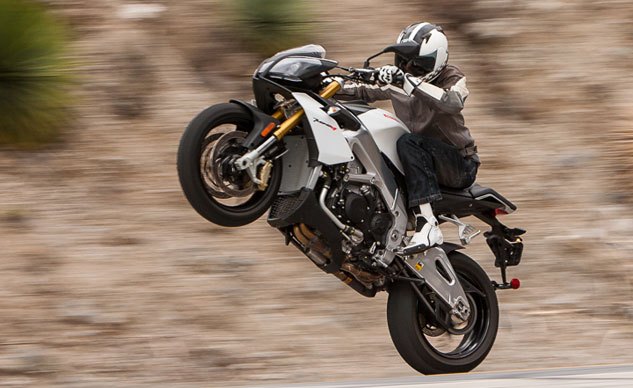
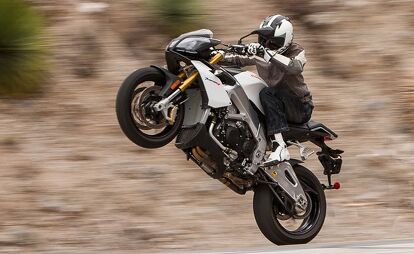






























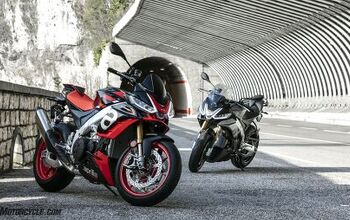
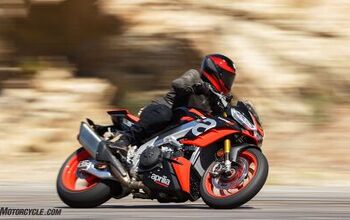
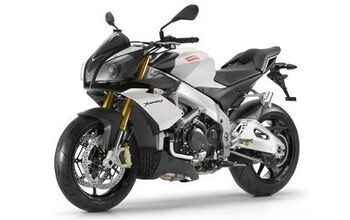











Comments
Join the conversation
2014 litrefighter comparison needed asap! Throw the street triple r into the mix as well.
As someone who's stuck in upstate New York waiting for riding weather (and un-salty roads), this review has been mind-rending to say the least. Last year I sat on a Tuono V4 and revved it up. I need to ride one.